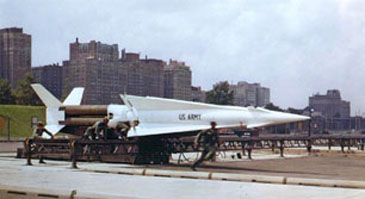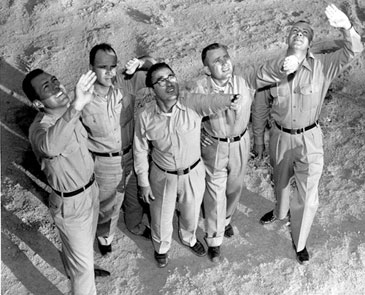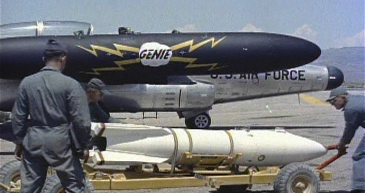|
 An Army Nike-Hercules nuclear antiaircraft missile and soldiers at launch facility on Belmont Street in Chicago, Illinois. 30 September 1959. This was the first such site in the United States. Today, all missile equipment and buildings are removed, and the area is under control of the Lincoln Park Boat Club. Photograph courtesy of Redstone Arsenal, United States Army. |
• Atomic anti-bomber weapons were displayed (unarmed) in many public venues, and some missile launch sites and manufacturing facilities held open houses. These arms were also visible in American pop culture, including in model kits (more here), cereal trading cards, a Lassie television episode, a hairstyle, in corporate advertising, and in several other ways. • A Genie rocket was test-fired from an Air Force plane over Nevada in July 1957. Five officer volunteers stood below (see photograph at right) to demonstrate that the weapon could be utilized without endangering those on the ground. The Air Force, aided by Ronald Reagan’s former Warner Brothers publicity agent (then an active duty colonel), undertook a considerable effort to publicize the exercise, which probably including being involved in a proposed Jimmy Stewart movie about the operation. The colonel was reprimanded when his work led to the revelation of the cost of the Genie’s W-25 nuclear charge, one of only two occasions in which the expense of a warhead has been made public. • In July 1958, extensive preparations had been made to test-fire additional Genies as well as Nike-Hercules missiles over the Gulf of Mexico. Days before the operation was scheduled to be conducted, Eisenhower canceled the test, in an Oval Office meeting with John Foster Dulles and others. • Eisenhower authorized in advance (or “predelegated”) the use of these arms in the event that an aerial attack upon the US was known to be underway but the president could not be contacted. This provision was publicly acknowledged in 1957 and 1958. • The Soviet Union was interested in the details of American nuclear antiaircraft arms. In 1958, the USSR's military intelligence agency recruited an Army lieutenant colonel (one of the highest-ranking US officials known to have engaged in espionage on behalf of a foreign power) to provide classified information about the Nike-Hercules. This activity was not uncovered until several years later when Soviet colonel Oleg Penkovskiy, an American agent, reported that the Army missile information was in the USSR's possession. • Considerable design, procedural, and operational restrictions were implemented to ensure atomic antibomber arms could be safely stored and handled. An alteration to shipping procedures probably sparked a complaint from the California governor and caused considerable consternation in the Eisenhower White House. In another instance, concern about the safety of the BOMARC warhead required President Eisenhower to approve sensitive diagnostic evaluations amidst a moratorium on nuclear testing. • Despite precautions, there were some mishaps involving nuclear air defense weapons. Most were minor. A BOMARC accident near New Jersey’s McGuire Air Force Base was more serious. • During the Cuban Missile Crisis, the Air Force altered its procedures to allow interceptors carrying defensive nuclear weapons to be airborne. The Army, by contrast, apparently discounted the possibility of an airborne attack being staged from Cuba. When Nike-Hercules units raced to Florida to establish an emergency antiaircraft defense of the area, the missiles with which they were equipped and were to be resupplied did not carry atomic warheads. • Between 1964 and 1986 atomic anti-bomber arms were withdrawn from the continental United States. The BOMARC was retired because the missile engine and guidance systems never performed as designed. In the case of the other weapons, policy-makers believed it was futile and expensive to protect against the possibility of attack by a few bombers at a time when the Soviet Union possessed a far greater number of Intercontinental Ballistic Missiles from which a defense was not readily available |
 Four Air Force BOMARC-A nuclear antiaircraft missiles arrayed for launch at facility on Long Island, New York (one and one half miles west of Gabreski Airport, formerly Suffolk Air Force Base, on north side of Old Country Road, in Westhampton, Suffolk County). Date unknown. Photograph courtesy of United States Air Force Museum.   crews prepare to attach a Genie to a U.S. Air Force F-89 Scorpion before a live aerial test firing of the rocket above the Nevada Test Site, July 19, 1957. Still photo taken from official U.S. Air Force film in the collection of the National Archives and Records Administration. |
A substantial number of declassified official histories and documents were consulted for this project, including a voluminous collection of nuclear weapon documents compiled by the late Chuck Hansen (now held by the National Security Archive), and material at the Dwight D. Eisenhower Presidential Library and the Department of Energy.